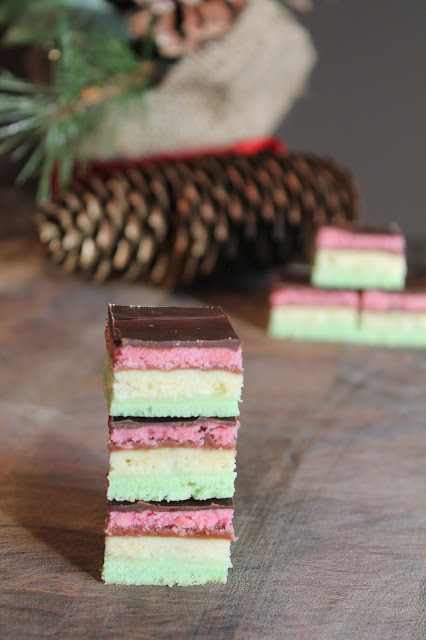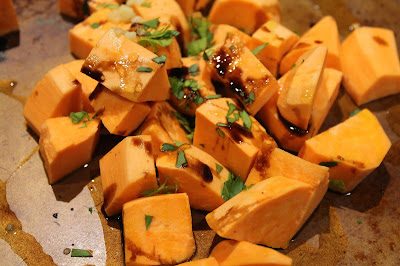This year, it's my turn to host family on Christmas Day - we usually get together to open presents and have a nice turkey dinner. I want the day to be like my childhood Christmases filled with lots of delicious food and no shortage of family fun. My mom had a way of making Christmas feel so cozy and nice; I have no memory of her being stressed out or overwhelmed - if she was, it never showed. Now that I'm an adult and my Mom is no longer with us, I want this Christmas to be like it was when I was a kid, where spending time with people you love was more important than everything being perfect.
When I say I don't want things to be perfect, that isn't to say I'm going to haphazardly slop some food together without caring. What I mean is, I don't want to become obsessed with everything being so perfect I end up in a corner crying in the fetal position because something didn't work out exactly the way I wanted. I've been to dinners or parties where the host is wound up so tightly from going all Martha Stewart, no one really has a good time. Instead, I'm going to make my life easier by creating a meal that is as equally delicious as it is easy to put together. Hopefully if I'm relaxed about things and enjoying myself, my guests and family will feel that way too. Besides, I don't want anything to get in the way of having a good time at Christmas, I wait all year for this!
Let's get down to brass tacks - the food... When I first started thinking about exactly what to make, my mind was already made up on Turkey dinner, it was just a matter of figuring out the sides etc. However, there are going to be 13 of us for dinner, and I just don't have a big enough table to comfortably seat that many people. My natural instinct is to do what my Mom did when we had more people than spots at the table, which was to have open seating around the house. Everyone just found a spot to sit and eat - be it the dining room table, or the couch. However, the more I thought about it, the more I wasn't keen since it might be difficult for people to balance plates on their laps and eat a full turkey dinner. I started thinking about the idea of doing a meal cocktail style which everyone could help themselves and the food would be easy to eat standing up. The only problem I saw with this idea was having to give up turkey for some other easy to eat menu. However, in my opinion, it's just not Christmas without turkey.
Well, I've come up with a way to have the best of both worlds by doing turkey and stuffing pinwheels, fried mash potato balls that will change your life, gravy (which is incredibly delicious, I make in advance, and is a Jamie Oliver recipe) all balanced with a nice green veg of asparagus. This way, everything can be eaten very easily while either standing up or sitting with a plate on your lap.
As well, a lot of this menu can be done a day or two in advance making the work on Christmas day super easy and stress free. The turkey and stuffing pinwheels can be assembled in advance and then popped in the oven later. Same goes for the potato balls - assembled in advance and then fried right before dinner is served. Lastly, the asparagus can be prepped ahead of time and then be stored in the fridge until roasted in the oven.
The only complicated part of this menu is that I butcher a whole turkey and take off the turkey breasts to make the pinwheels. The reason I'm doing it this way, is because I already have a whole turkey in the freezer ready and waiting to go. However, you could just as easily buy two turkey breasts from a butcher or the grocery store instead. Oh and don't worry, I don't waste the remaining parts of the butchered turkey - I use it to make stock for the next time I have turkey.
Here's my recipe:
2 turkey breasts (either butchered from a whole turkey or bought already removed)
1 tablespoon of olive oil
1 tablespoon of butter
1 medium onion finely chopped
1 clove of garlic minced
Fresh thyme, rosemary and sage finely chopped to taste
2 cups of cubed stale bread (store bought is just fine)
Salt and pepper to taste
Handful of dried cranberries (optional)
3/4's cup of chicken or turkey stock
Preheat oven to 350 degrees F.
If you want to try sectioning the turkey, I highly recommend checking out the BC Turkey site as it has easy step by step directions for doing so.
Cut each turkey breast in half across the grain (not down the middle of the breast, see the BC turkey site above), so you have four pieces of breast. Place one of the breast pieces between two large sheets of plastic wrap or parchment paper large enough to cover the breasts and allow enough extra room for them to expand once flattened. Using a meat mallet or a heavy rolling pin, bash the meat all over until it's flattened out to about a 1/4 inch thickness. It's great if you do this rather evenly, but don't fuss if you have some thicker and thinner parts, it will still work out fine. Alternatively, you could purchase 4 large turkey scallopini's from a butcher, though it's a little pricey.
Store the turkey scallopini in the fridge while you prepare the stuffing. Heat a medium skillet over low to medium heat and add the olive oil and butter. Add the onion, garlic and herbs and cook until the softened. Add the bread, stirring well to combined with the onion mixture. Once the bread is broken up and toasted a little, add the cranberries (if using) and season with salt and pepper to taste. Add the stock and allow the mixture to continue cooking un-covered until the bread has mostly absorbed the stock. Set aside to cool slightly before assembling the pinwheels.
Lay out a sheet of aluminium foil and then some parchment paper (on top of the aluminium foil) both slightly larger than the flattened turkey scallopini. Drizzle a little olive oil on the foil/parchment, then lay one of the scallopini pieces down, and scoop some stuffing on the turkey. Spread the stuffing out in an even and and fairly thin layer; too much and the stuffing with get squished out of the pinwheel. Roll up the turkey into a log and then wrap in the paper and foil so that the turkey log is fully encased. Twist up each end of the aluminium foil to seal the whole thing and place on a baking tray. Repeat with the remaining turkey scallopini pieces. Bake in a 350 F oven for 40 minutes by which time the turkey will be cooked through. As well, you could puncture through the aluminium/parchment paper to test the turkey with a meat thermometer if you wanted to double check, it should be 180 degrees F. Allow to rest in the foil packages for at least 20 minutes before serving. Un-wrap and slice into 1/4 inch thick pinwheel slices and serve.
One additional thing I like to do is sear the cooked, un-wrapped and un-sliced logs in a hot skillet for a few minutes on each side and then slice. I prefer the look of the nicely browned outside as opposed to the plain pinwheel. You could absolutely leave this step out if you prefer or don't have time. Lastly, since I originally posted this recipe, I've made it again and made one slight addition... I grated some mandarin zest over the turkey before wrapping in aluminium foil and baking in the oven. I had some on hand and it added a nice brightness to the meal. However, you could certainly leave this out, if you don't have an orange around.
Fried Mashed Potato Balls:
(This is a fantastic way to use up left over mashed potatoes)
2 pounds of potatoes cooked, mashed, buttered, seasoned and cooled completely in the fridge.
4 cups of Panko bread crumbs
3 eggs
Salt and pepper to taste
Canola or vegetable oil for frying
Set out two medium sized (preferably shallow) bowls and add the Panko bread crumbs to one and whisk the eggs in the other. Season both bowls with a generous amount of salt and pepper. Take a small handful of cold mashed potatoes and roll between your hands into small ball (about the size of a chocolate truffle). Then dip and coat the ball in egg, and then dip and coat the ball in Panko bread crumbs. Place on a baking tray while you get on with the remaining mashed potatoes until done.
Add oil to large sized dutch oven or pot, enough oil to fill the pot at least 1/4 full but no more than 1/2 full. Heat the oil to 350 degrees F (if you have a thermometer) or hot enough that when you drop a couple bread crumbs they sizzle and start to brown within 30 seconds (they shouldn't burn within that time or the oil is too hot).
Fry the balls in batches, to prevent crowding of the pan, until nicely browned. Place the fried balls to drain on a baking sheet lined with some paper towel. You can store in a low oven (about 225 degrees F) to keep warm until ready to serve dinner.
Roasted Asparagus:
2 bunches of asparagus, woody ends trimmed off.
1/4 cup olive oil
Clove of garlic, finely grated or chopped
1 teaspoon of red pepper flakes
Lemon juice to taste
Salt and pepper to taste
Prosciutto (optional)
Preheat oven to 425 degree F. Line two baking trays with aluminium foil (for easy clean up).
Clean and trim asparagus, then toss in the olive oil, garlic, red pepper flakes, and lemon juice. Then sprinkle over some salt and pepper. Wrap Prosciutto around each asparagus spear (optional) and lay out evenly between the two baking trays and bake in the oven for 5 to 8 minutes until the ends start to slightly brown but they're still mostly vibrant green and the prosciutto is nicely crisp.




















































